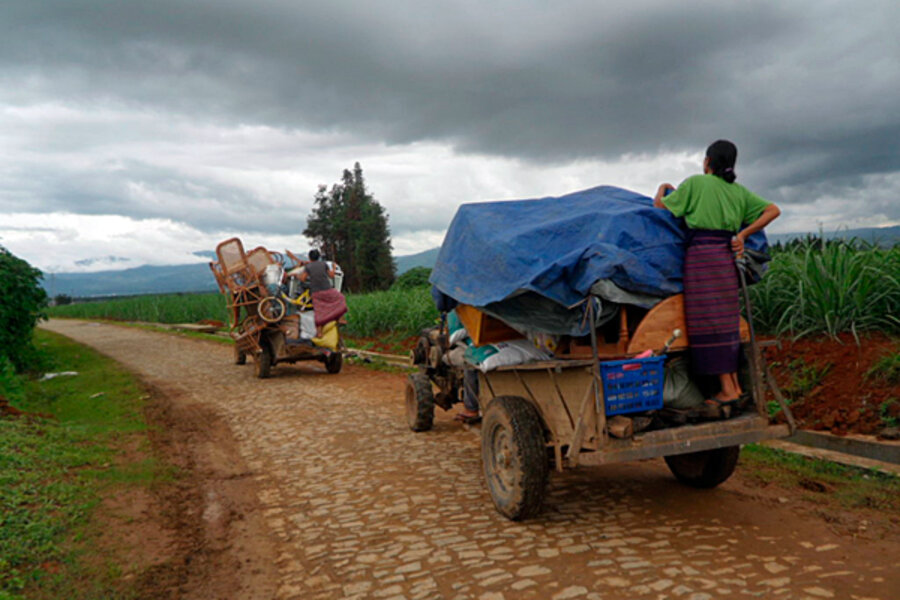Burma (Myanmar) border conflict threatens to complicate ties with China
Loading...
| Bangkok, Thailand
Deadly clashes between Burmese troops and ethnic rebels at a Chinese-run hydropower dam for nearly two weeks shine a spotlight on China’s growing energy interests in Burma’s strife-torn borderlands. (See map here)
Beijing has called for a peaceful end to the fighting in Burma's northern Kachin state (see map here), where Chinese power companies are building a series of dams to supply electricity to southern China. The latest fighting erupted on June 9, when Burmese forces tried to secure a Chinese dam that is already in operation and has since been forced to shut down. Thousands of civilians have fled the area, and some have crossed into China, according to exiled Burmese media and Western diplomats in Bangkok.
Analysts say China is caught between its need to secure energy supplies from Burma (Myanmar) and its fears of escalating conflict on its borders.
The conflict represents a challenge for Burma’s semicivilian government that took power in April following a controversial election last November that sidelined many opposition voices. The ethnic minority Kachin Independence Army (KIA) is among several armed groups in Burma that have refused to convert into government border guards, to the frustration of Burma’s powerful military. Its political wing, the Kachin Independent Organization (KIO), signed a cease-fire in 1994 but was unable to field candidates in last year’s election.
What do Burmese troops really want?
Lahpai Naw Din, an exile who runs the Kachin News Group in Thailand, said the dam was a smokescreen for Burmese troops to overrun KIA positions. “It’s just a trick. In a short time they want to invade and control the dam area,” he says.
The hydropower plants lie on a tributary of the Irrawaddy River that flows the length of Burma and empties into the Indian Ocean. In March, the KIO sent a formal letter to the Chinese government to register its objections to dams under construction on the upper reaches of the river and cited the risk of conflict if Burmese troops attempt to drive the KIA from its bases.
“The KIO would not be responsible for the Civil War if the War broke out because of this Hydro Power Plant Project and the Dam construction,” the letter said.
The fighting in Kachin state comes at a sensitive time for President Thein Sein, a retired general who struck a conciliatory tone toward ethnic minorities in his inauguration speech but hasn’t followed up with any concrete policies. Some Kachin argue that the new government is no better than the disbanded junta and leans toward confrontation, not negotiation.
Burma’s state media said the KIA refused to withdraw its troops from the Tarpein dam site, despite repeated warnings, and resisted with heavy weapons that had damaged power lines and bridges. More than 200 Chinese workers had been evacuated and the plant shutdown had caused “great loss to the state and the people,” it said.
Exiled media groups had reported a lull in fighting in recent days as the two sides held peace talks, but clashes resumed Monday amid Kachin claims that Burma was moving troop reinforcements into the remote area near the Chinese border. Attempts to reach KIA representatives in Thailand and Burma were unsuccessful.
It’s unclear to what extent the fighting in Kachin state is driven by local military objectives. A KIO official said last week that he didn’t believe that the orders were coming from Nyapyidaw, the capital. Western diplomats say Thein Sein has struggled to consolidate his power base and faces resistance from military commanders, despite his former rank.
Burma's delicate dance with China
Last month, he made his first overseas state visit to China, Burma’s largest trading partner, which is building an oil and gas pipeline across Burma. A Burmese crackdown on a smaller ethnic militia group in August 2009 led more than 30,000 refugees to cross into China. An all-out offensive against the KIA, which has at least 8,000 soldiers, is certain to take a larger toll.
Naw Din said that the peace talks had failed because the Burmese government envoy wasn’t authorized to make concessions. He said a cease-fire was possible, but would still leave both sides on a war footing in the absence of political talks.
While the dam projects represent a useful source of clean energy, China’s biggest energy bet on Burma is the twin pipeline that is designed to transport imported crude oil as well as gas from Burma’s offshore reserves in the Indian Ocean. To reach China, the pipeline would have to pass through borderlands where the KIA and other rebel groups have military bases.
Matthew Smith, a consultant for EarthRights International, a US-based campaign group, said the pipeline’s planned route lies south of the scene of the latest fighting. But he warned that it appeared to pass another area now under the KIA’s control. “It’s an unwise business proposition to be laying a pipeline through a war zone at such an inopportune time,” he says.





